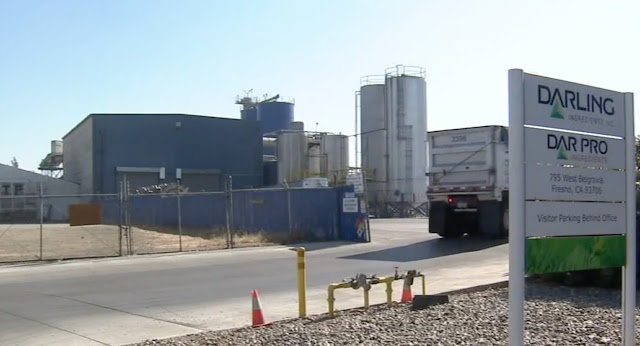
Darling Ingredients, Inc. rendering plant in Fresno, CA.
The following is from the poster presented at the 2022 New Horizons in Conservation Conference at the Yale School of the Environment.
Abstract
Since 1969, Darling Ingredients, Inc. has operated an animal rendering plant in Bayview-Hunters Point (BVHP), a low income community of color in San Francisco, CA. The plant’s noxious emissions along with several other pollution sources put BVHP in the 90th percentile for pollution and health risks in the entire state, according CalEnviroScreen 3.0. The complex web of local, state, and federal environmental regulations and enforcement agencies make it difficult for average community members to determine the facility’s compliance. Through a quantitative review of public documents from three enforcement agencies, we conclude that Darling is generally in compliance. We then offer recommendations for reducing the facility’s health and environmental impacts that may be applicable to similar facilities.
Introduction
“Animal rendering” is the conversion of animal tissue into usable materials through heating, extracting moisture, and separating fats from raw animal carcasses at temperatures more than 140˚ F. The resulting material is primarily used for animal feed, but has applications in other areas such as, lubricants, soaps, plastics, cosmetics, and paints. Recently, Darling expanded its operations to produce biodiesel.
BVHP is inundated by multiple pollution sources, including the Hunters Point Naval Shipyard Superfund site, a sewage treatment plant, three concrete production plants, two major freeways, and Darling’s animal rendering plant. BVHP residents and employees have complained about the plant’s fumes (“like burnt animal”, “gut pinching”, “makes me dizzy and nauseous”); many suspected Darling was out of compliance with environmental regulations.
There are seven local, state, and federal agencies responsible for monitoring Darling’s operations and enforcing environmental regulations. We examined (1) the Bay Area Air Quality Management District (BAAQMD), (2) the Port of San Francisco, and (3) the San Francisco Planning Department. BAAQMD is responsible for regulating air emissions under the Clean Air Act and erequires any operator of a machine or equipment that emits air pollution to obtain a permit to operate (PTO). This PTO sets emission limits and subjects the operator to various permit conditions, such as the installation of pollution control technology and a prohibition on public nuisance.
The Port and Planning Department also issue environment-related permits, but these generally apply to time-bound, construction-related events.
Research Methods & Activities
Given our focus on air quality and because BAAQMD regulates Darling’s ongoing air emissions, whereas the Port and Planning Department have time-bound, construction-related involvement in Darling’s operations, the study and this poster focuses primarily on BAAQMD. The full report includes our findings for all three agencies.
Through California Public Records Act requests to the three agencies, we obtained documents related to Darling’s operations between 2003 and 2021. Files included permit applications and environmental impact reports, operational permits, inspection reports, and notices of violation. Data was also obtained from the BVHP community-based environmental monitoring and reporting network, IVAN. We also conducted informal interviews with our community partner and other EJ advocates, and analyzed news articles, agency press releases, and other secondary sources for supplemental information.
Darling’s compliance was determined by comparing permitted emissions with reported emissions, reviewing inspection reports, and tabulating public complaints submitted and violations issued within this timeframe.
Findings
Documents from BAAQMD yielded the most relevant data on air emissions. We note that BAAQMD generally did not conduct its own independent monitoring and relied instead on data provided by Darling to track compliance, a common regulatory practice.
Between 2003-2021, BAAQMD received 48 public complaints and issued 2 notices of violation. We noted different treatment for violations of public nuisance rules vs. permit conditions. In 2004, BAAQMD issued Darling a violation after receiving 10 complaints of foul odors from employees of a nearby concrete plant. Documents did not reveal the results of this violation. Conversely, a 2006 permit violation for failing to maintain proper temperatures for an oxidizer resulted in a $11,000 fine. On the limited number of complaints and violations, our community partner explained that residents had eventually “given up” filing complaints with BAAQMD, which the agency confirmed. Other than these violations, Darling appears to be in compliance with BAAQMD air regulations.
Other Agencies
Documents from the Port largely pertained to Darling’s construction a conveyor support transfer station and installation of a 5,000 gallon storage tank in 2016. Based on our initial review, Darling is likely in compliance with its requirements from the Port.
In 2008, Darling applied for a permit from the Planning Department to expand its operations to begin biodiesel production. The Department initially granted a categorical exemption, meaning Darling was not required to conduct an Environmental Impact Report (EIR) to assess the health, environment, or quality of life impacts of the expansion. Following public criticism and litigation, the Department completed a supplemental report, which concluded that the expansion would not cause new significant environmental impacts and was thus exempt from an EIR. Due to the short statute of limitations period, advocates were unable to further challenge the biodiesel expansion.
Conclusions/Recommendations
We offer a mix of enforcement, policy, and closure recommendations to protect BVHP from the harmful impact of Darling’s rendering plant.
Our findings suggest a need for stronger enforcement of environmental regulations and more stringent emission limits. We recommend agencies work with the community to develop guidelines for increased transparency and public involvement in enforcement, and fully implement environmental justice policies with specific, measurable goals and accountability mechanisms. We also recommend community monitoring of Darling’s emissions. If these efforts fail to make sufficient health and environmental improvements, advocates may seek plant closure; for that, we recommend an an example the successful campaign in Fresno, CA to shut down Darling’s 60-year old plant, which is scheduled to close by December 2023.
Finally, we recommend further research into the appropriateness of permitted emissions limits.
See poster below: